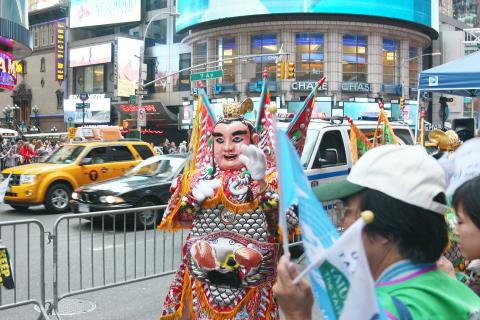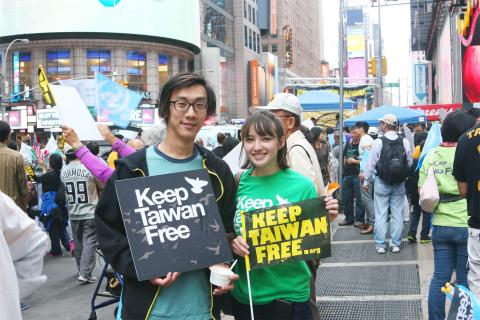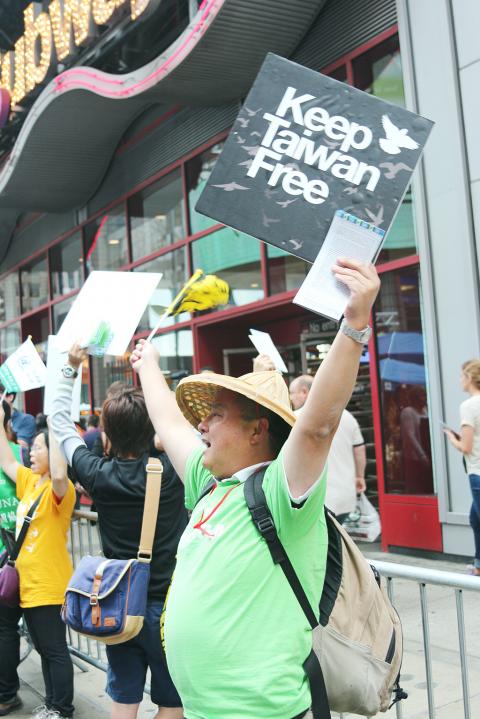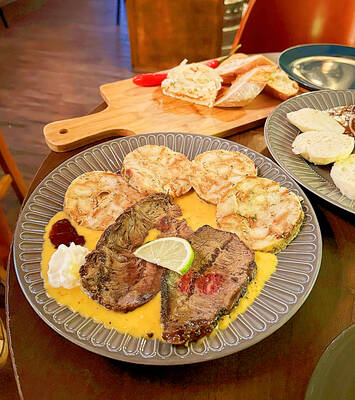Amid overcast skies and a steady rain that fell for much of the afternoon, more than 200 Taiwanese converged on Times Square Saturday to call for Taiwan’s inclusion in the UN, and to raise New Yorkers’ awareness of the island nation and its political struggles.
“If you want to love Taiwan, then you have to learn about Taiwan,” said Eric Tsai (蔡宗霖), 23, co-director of this year’s Keep Taiwan Free rally.
Tsai, who was born in California and grew up in Taiwan, said they also circulated two petitions among attendees: one to demand that Taiwan’s government amend a law requiring at least 50 percent voter turnout to pass a referendum, the other to ask that US Secretary of State John Kerry review the one-China policy recognizing the People’s Republic of China (PRC) as the legitimate representative of China.

Photo: Chris Fuchs
Since 1993, overseas Taiwanese in New York have participated in this annual rally, also attended by the Taiwan United Nations Alliance (台灣聯合國協進會). In the past, Tsai said, thousands of protesters would descend on the Manhattan streets outside the UN, which gave the island’s seat to the PRC in 1971.
Sovereignty
Taiwan is one of only three countries not in the UN. The PRC has repeatedly blocked efforts by Taiwan to join, arguing that the nation, which it views as a breakaway province, is not a sovereign nation.

Photo: Chris Fuchs
Organizers chose to hold this year’s event in Times Square and did not march to the UN since the 69th General Assembly does not convene until Sept. 16, Tsai said. They were also hoping to attract a younger generation of Taiwanese to augment the ranks of older participants who have been active in this movement for decades, he said.
The dreary weather Saturday did not dampen the spirits of those who attended the three-hour rally. To keep the crowd energized, live bands performed on a makeshift stage, penned in by metal police barricades, and the Taiwanese American Association of New York (大紐約區台灣同鄉會) Santaizi (三太子) Troupe, dressed in colorful head-to-toe costumes of various gods and deities, strutted their stuff in front of smiling protesters waving yellow-and-black flags that read Keep Taiwan Free.
Education

Photo: Chris Fuchs
This year’s event also helped educate everyday New Yorkers about Taiwan, organizers said. Dressed in Keep Taiwan Free t-shirts, many attendees lined up along the sidewalk barriers set up by police, handing out literature and flags to passersby as they made their way down 42 Street.
One participant, Melissa Daly, 23, said she made the trek in from nearby New Jersey with her friend Jenny Wang (汪采羿), her high school classmate, also 23, and the event’s other co-director. But Daly said she also has a personal investment in the movement — she is half-Taiwanese.
“When people think Taiwan is part of China, I always feel the need to say something,” said Daly, whose mother was born and raised in Taiwan.
Jason Chen, 23, also attended the rally after learning about it through his friend Daly. Like the others, Chen, whose parents are from Taiwan, echoed a similar sentiment that Taiwan should finally be allowed into the UN to join the international community of nations.
He also said he views himself as a cultural ambassador for Taiwan.
“When people ask, I try to be informative and paint a good picture of Taiwan and Taiwanese values,” Chen said.
In the long run, organizers explained, outreach to overseas Taiwanese and Americans alike is an important step toward countering the growing threat that China poses to this democratic island nation.
“It takes time,” Wang said. “But right now, we’re in Times Square. People are going to see this, and maybe they’ll Google it. It’s little events like this one that make a difference.”

Seven hundred job applications. One interview. Marco Mascaro arrived in Taiwan last year with a PhD in engineering physics and years of experience at a European research center. He thought his Gold Card would guarantee him a foothold in Taiwan’s job market. “It’s marketed as if Taiwan really needs you,” the 33-year-old Italian says. “The reality is that companies here don’t really need us.” The Employment Gold Card was designed to fix Taiwan’s labor shortage by offering foreign professionals a combined resident visa and open work permit valid for three years. But for many, like Mascaro, the welcome mat ends at the door. A

Divadlo feels like your warm neighborhood slice of home — even if you’ve only ever spent a few days in Prague, like myself. A projector is screening retro animations by Czech director Karel Zeman, the shelves are lined with books and vinyl, and the owner will sit with you to share stories over a glass of pear brandy. The food is also fantastic, not just a new cultural experience but filled with nostalgia, recipes from home and laden with soul-warming carbs, perfect as the weather turns chilly. A Prague native, Kaio Picha has been in Taipei for 13 years and

Since Cheng Li-wun (鄭麗文) was elected Chinese Nationalist Party (KMT) chair on Oct. 18, she has become a polarizing figure. Her supporters see her as a firebrand critic of the ruling Democratic Progressive Party (DPP), while others, including some in her own party, have charged that she is Chinese President Xi Jinping’s (習近平) preferred candidate and that her election was possibly supported by the Chinese Communist Party’s (CPP) unit for political warfare and international influence, the “united front.” Indeed, Xi quickly congratulated Cheng upon her election. The 55-year-old former lawmaker and ex-talk show host, who was sworn in on Nov.

Even the most casual followers of Taiwan politics are familiar with the terms pan-blue and pan-green. The terms are used so casually and commonly with the assumption that everyone knows what they mean, that few stop to really question it. The way these terms are used today is far broader and extensive than what they were originally created to represent. Are these still useful shorthand terms, or have people become so obsessed with them that they color perceptions to the point of distortion? LEE TUNG-HUI WAS NO SMURF People often assume that these terms have been around forever, or at least as